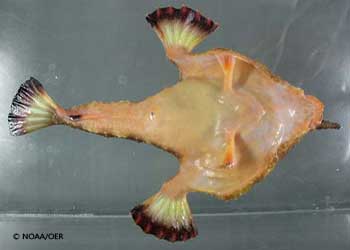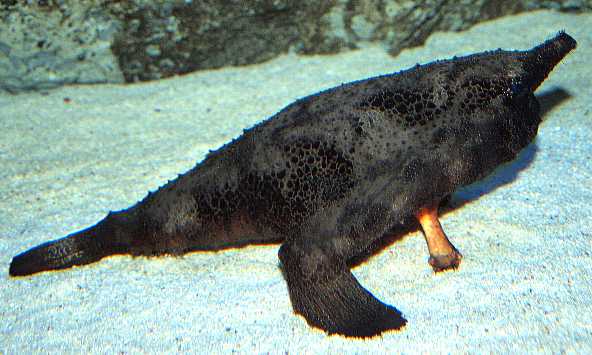
Ogcocephalus corniger
FAMILY
Ogcocephalidae
TAXONOMY
Ogocephalus corniger Bradbury, 1980.
OTHER COMMON NAMES
None known.
PHYSICAL CHARACTERISTICS
Most batfishes are dorsoventrally flattened. They have only a
single, very short dorsal fin spine (the illicium), although the
vestige of the second spine may be present but embedded. The
illicium usually is contained within a deeply concave illicial cavity,
and it typically extends forward and downward rather than
forward and upward, as in most other anglerfishes. The skin is
covered with prominent, tubercle-like scales, which may be very
large and conical (bucklers) in some genera. The scales fuse at
the anterior end of the snout, forming a moderate to greatly
elongated rostrum. The mouth is relatively small compared with
other anglerfishes and has small teeth. The longnose batfish has
a long, slender rostrum at the end of a triangular head and dark
bands of pigment on the distal portions of the pectoral and caudal
fins. The overall body color is dark brown or gray, with
small, pale spots uniformly distributed on the dorsal surface.
DISTRIBUTION
The longnose batfish inhabits the western Atlantic from Cape
Lookout, North Carolina, south to the Yucatan Peninsula, including
the Gulf of Mexico and the Caribbean. It has been
taken at depths ranging from 95 ft (29 m) to 755 ft (230 m).
HABITAT
All batfishes are benthic, occurring on a wide variety of bottom
types.
BEHAVIOR
Unknown.
FEEDING ECOLOGY AND DIET
Batfishes feed using aggressive mimicry, as do most anglerfishes;
however, they are unusual among anglerfishes in that a greater
proportion of their diet seems to be small, benthic invertebrates.
REPRODUCTIVE BIOLOGY
Unknown.
CONSERVATION STATUS
Not threatened.
SIGNIFICANCE TO HUMANS
None known.
Photo Gallery of - Longnose batfish





 Animalia Life
Animalia Life